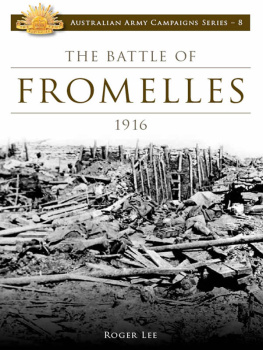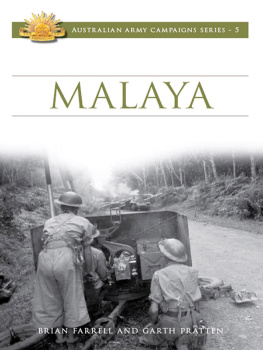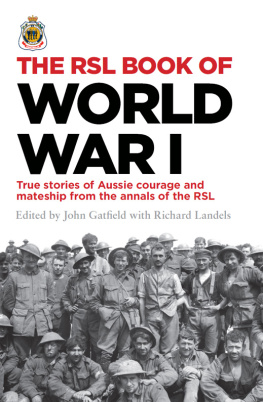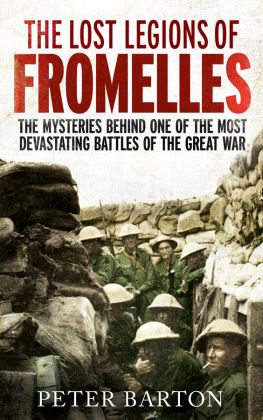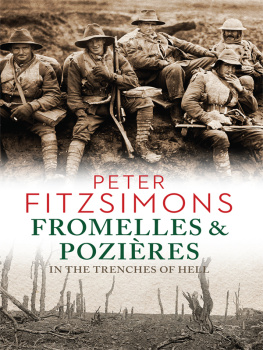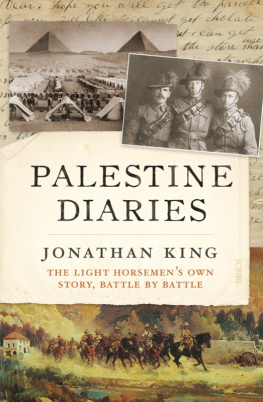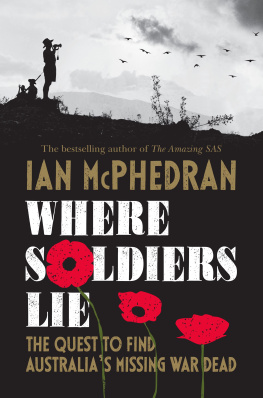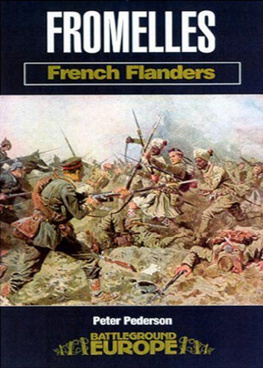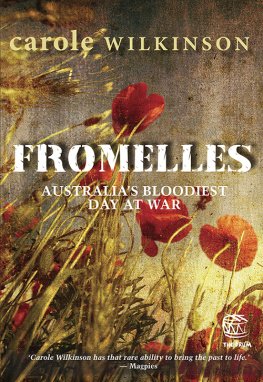 | AUSTRALIAN ARMY CAMPAIGN SERIES 8 |
THE BATTLE OF
FROMELLES
1916

ROGER LEE

2010
Copyright Army History Unit
Campbell Park Offices (CP2-5-169)
Canberra ACT 2600
AUSTRALIA
(02) 6266 4248
(02) 6266 4044 fax
Copyright 2010 Commonwealth of Australia
First published 2010
This book is copyright. Apart from any fair dealing for the purposes of private study, research, criticism or review as permitted under the Copyright Act, no part may be reproduced, stored in a retrieval system or transmitted in any form or by any means, electronic, mechanical, photocopying, recording or otherwise,without written permission.
National Library of Australia Cataloguing-in-Publication entry
| Author: | Lee, Roger. |
| Title: | Battle of Fromelles / Roger Lee. |
| Edition: | 1st ed. |
| ISBN: | 9780980658293 (pbk.) |
| Series: | Australian Army Campaign Series; 8. |
| Notes: | Includes bibliographical references and index. |
| Subjects: | Fromelles, Battle of, Fromelles, France, 1916.
World War,1914-1918CampaignsFranceFromelles.
World War, 1914-1918Participation, Australian. |
| Dewey Number: | 940.427 |
Layout and design by Margaret McNally, Canberra, ACT
Printed in Australia by Big Sky Publishing, Sydney
Front Cover: Part of the German front line after the Battle of Fleurbaix which took
place on 19 and 20 July 1916. AWM A01560
Title Page: Part of the German front line after the Battle of Fleurbaix which took
place on 19 and 20 July 1916. AWM A01553
CONTENTS

SERIES INTRODUCTION
In 2004, the then Chief of Armys Strategic Advisory Group (CASAG), the Armys senior generals, established a scheme to promote the study and understanding of military history within the Army. The focus was the Armys future generation of leaders and, from this, the Campaign Series was created. The series is intended to complement the Armys other history publications which are major analytical works of high quality, academically rigorous and referenced.
The Campaign Series focuses on leadership, command, strategy, tactics, lessons and personal experiences of war. Each title within the series includes extensive visual sources of information maps, including specifically prepared maps in colour and 3D, specifically commissioned artwork, photographs and computer graphics.
Covering major campaigns and battles, as well as those less known, the Army History Unit and its Campaign Series provide a significant contribution to the history of the Australian Army and an excellent introduction to its campaigns and battles.
Roger Lee
Army Historian
ACKNOWLEDGEMENTS
The first book is always a very steep learning curve for any author. This book was no exception and, during the long period of its preparation, I relied heavily on a number of people to provide ideas, support and, above all, encouragement. My colleagues in the Australian Army History Unit, especially Lieutenant Colonel Bill Houston and Dr Andrew Richardson, were always a source of advice and encouragement, with Andrews computing skills often extricating me from one disaster or another. Professor Gary Sheffield, Major General Mike OBrien, Major Dr Michael Tyquin and Mr Nick Fletcher all read early versions of the manuscript, offered many helpful and insightful comments and suggested corrections, thus sparing me much embarrassment. Any errors that remain are thus entirely my own. Craig Tibbitts at the Australian War Memorial promptly delivered material or advice on request and I owe much to Peter Barton and our many lively discussions on this battle. Indeed, some of his wisdom has found its way into these pages.
My gratitude extends also to the team of experts who have added so much to the book itself: Mark Wahlert for his maps and images, Jeff Isaacs for his wonderful artwork, Glenn Wahlert, the Project Director, for his calmness, patience and whip-wielding; and, of course, my patient, long-suffering editor, Cathy McCullagh. Margaret McNally was at her professional best with the typesetting and book design.
Finally, and not least, I must acknowledge and thank some others not connected directly with these pages. It is entirely due to the skill and persistence of oncologist Dr Paul Craft and surgeon Dr Charles Mosse that I am still around and able to write these words. While others may curse them, I am clearly in their debt. Last on my list but first in line for my gratitude is, of course, my wife Jenny, who has added to the English language a variant on the golf widow and football widow damned book widow.

Location of Fromelles.
(Mark Wahlert)
FROMELLES: THE BATTLE AND ITS STRATEGIC SETTING
INTRODUCTION
At six oclock on the evening of Wednesday 19 July 1916, the British 61st (2nd South Midland) Division and the 5th Australian Division began the attack that was to become known as the Battle of Fromelles. Within twenty-four hours, the 61st Division had suffered 1,547 casualties while the 5th Division had lost 5,533 men a total that included over 1,700 dead or missing. In terms of total numbers, this remains the bloodiest twenty-four hours in the history of the Australian Army. There would be higher casualties in the battles on the Somme a few days later (but fought over a longer period) and with the surrender of the 8th Division in Singapore in the next war, but the catastrophic loss rate that characterised the Battle of Fromelles remains unsurpassed. Yet, surprisingly, there was little official recognition of the catastrophe at the time and, until recently, the battle was almost unknown outside the pages of the Australian Official History.
The focus of most history writers on the numbers killed or wounded has generated an understandable emotional revulsion against the whole experience of World War One. No historian debating arcane issues of loss rates is ever likely to overturn this natural and understandable reaction. Nonetheless, the total number of casualties is not a reliable pointer to the competence or incompetence of the commanders or the effectiveness of the defenders. The size of the casualty count is due almost entirely to the number of soldiers involved. The British Empire fielded the largest army in its history on the Western Front in 1916. Even a low casualty rate that is, the proportion of casualties as a percentage of totals involved still resulted in enormous numbers of dead soldiers.
The Battle of Fromelles had barely ended before the onset of recriminations. Eventually, after senior officers including the commander of the 5th Australian Division were replaced and other battles fought, the controversy ebbed and faded. The discovery in 2009 of the remains of 250 missing Australian and British war dead, casualties of the Battle of Fromelles, ignited a new wave of speculation and opinion. Unfortunately, in the more than ninety years since Fromelles, current opinion has often been influenced by ideas and issues notably absent on 19 July 1916. A number of myths and misrepresentations have evolved which distort understanding of what happened and do a disservice both to the soldiers who fought the battle and to those who planned and conducted it. Conspiracy theories concerning official British attempts to downplay the tragedy add little to the debate but have undergone something of a renaissance in recent times.

